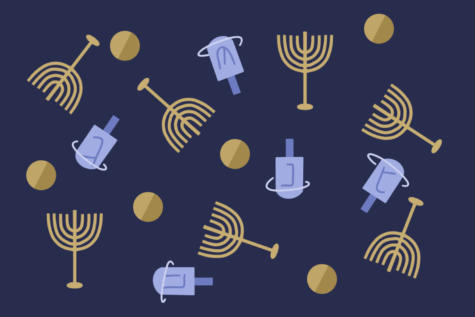Two Jews’ guide to Hanukkah
December 1, 2021

Some Tulane University students may have noticed the enormous candelabra outside the Lavin-Bernick Center this winter. Although Tulane is 40% Jewish, for non-Jewish students and community members, the religion’s many holidays and practices may be confusing. In debunking some of this mysticism, here is everything you need to know about Hanukkah, the Jewish winter festival of lights.
The history of Hanukkah dates back to 168 B.C. when Syrian King Antiochus IV deployed his soldiers to Jerusalem. During this crusade, Antiochus IV destroyed the Temple, the central place of Jewish worship, and outlawed the practice of Shabbat, Jewish festivals and circumcision. Antiochus IV forced the Jews to choose between worshiping the Greek gods or death.
The reign of Antiochus IV sparked a Jewish resistance movement led by the Hasmonean family known as the Maccabees. Judah Maccabee, the family’s son, spearheaded the military arm of the resistance, winning two major battles against the Syrians, ultimately defeating Antiochus IV’s army.
The story of Hanukkah begins with Judah Maccabee and his men reclaiming the Temple from the Syrians. The Maccabees relighted the “ner tamid,” the eternal light. However, they found a singular jar of oil that would only keep the ner tamid lit for one day.
The Maccabees sent a messenger to acquire more oil and his journey took eight days. By some miracle, the single jar of oil burned for all eight days.
Hanukkah includes several important traditions. The most well known practice is the lighting of the hanukkiah, a nine-branched candelabra reminiscent of ner tamid. The hanukkiah is lit for eight nights to commemorate the sacred oil in the Temple that burned for that duration. Each night, an additional candle is added and a blessing is said over the candles before lighting. The center-most candle is referred to as the “shammash” and is used to light the candles each night.
Cuisine is central to Hanukkah, and Jews eat fried food to commemorate the sacred oil of the ner tamid. These staples include “latkes,” potato pancakes, and “sufganiyot,” jelly-filled doughnuts.
During Hanukkah, Jews play a game using a “dreidel,” a spinning top marked with the words “nes gadol haya sham,” which translates to “a great miracle happened here.” The dreidel pays homage to Jews secretly practicing their religion under Syrian rule — the Jews would pretend to play with dreidels to avoid being caught studying holy texts.
The story of Hanukkah provides various important lessons to Jews. The tale of the Maccabees touches on themes of power and powerlessness. The Maccabees, although much smaller than the Syrian army, secured a military defeat despite apparent weakness.
In lighting the hanukkiah and remembering the ner tamid, Jews ponder the search for light in dark times. To that same accord, the story of Hanukkah serves as a reminder of Jewish resilience amidst adversity.
Hanukkah has evolved throughout the centuries most notably with the incorporation of gift giving. Traditionally, exchanging gifts occurred during the Jewish holiday of Purim. However, as Christmas gift giving gained prominence, American Jews in the late 19th century added presents to the celebration.
The interpretation of Hanukkah’s origins has also evolved. Modern historians believe the Maccabees were fighting not only against the Syrians, but also against fellow Jews, who had adopted some Greek religious practices, including idolatry.
Next time you walk by the campus hanukkiah, stop by Dunkin’ Donuts and treat yourself to some sufganiyot.






















Leave a Comment